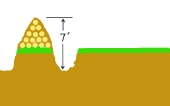Edward Norton wrote:I went for the ‘cheap boards’ and replace option. The boards were free - all upcycled from stuff I found in the basement, mostly the previous owners shelving which was in the wrong place. If I’m still here in 5 to 10 years then I’ll looking to some of the other options.
Thanks for all the tips. I’m yet to find a ‘proper’ saw mill, all the lumber yards I’ve visited are only interested in working with contractors and there’s no actual evidence of anything being milled on site. They’re what I’d call ‘builders merchants’ in the UK.
Until this picture I totally misunderstood what you were trying to do. And now you have done it, so my thoughts are now "after" thoughts. But anyhow, for future readers.
My two thoughts.
1. The wood chips will tumble down where mounded, but it should reach a somewhat stable level as it breaks down. So you could just end the wood chip mulch a foot or 30 cm back from the fence. This would also give you some room for cutting grass.
2. If you had a lot of field stone you could make an edge border with that. It would easily hold back the chips. But it would be harder to deal with, since you can't scythe/mow easily around rock borders, and unwanted perennial volunteers love edge borders like that.








